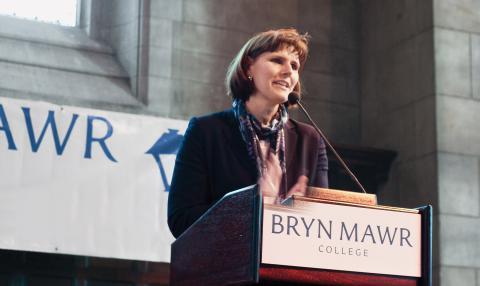For Admissions, Science Meets Art
Providing easier ways for engagement with Bryn Mawr also generates greater interest.

Dear Friends:
At selective colleges, February is a time of assessing thousands of applications and of beginning to shape the class of students that will arrive on campus in the late summer. While the goals of Bryn Mawr’s recruitment and admissions process remain constant—to enroll talented students of diverse interests and backgrounds who share a passion for learning—the college admissions process has changed substantially over the past decade.
Bryn Mawr’s new chief enrollment officer, Cheryl Horsey, Ph.D. ’99, describes contemporary admissions work as “an art and a science.” The “art” of building personal connections with prospective students will be familiar to Bryn Mawr alumnae of all generations. Many of you remember a tour guide, an alumna interviewer, or an admissions staff member who made Bryn Mawr come alive for you. The “science” of enrollment, however, has emerged over recent decades as colleges and educational organizations have learned to analyze the reams of data they collect to be more effective in communicating with prospective students and in planning recruitment strategies
For example, Bryn Mawr now uses a software platform that integrates the work of student outreach, admissions staff travel, prospective student visits, recruiting events, and application review. While this digital strategy seems far away from traditional relationship-building between a student and a college, technology in fact enhances our admissions staff’s ability to respond to prospective students in real time and to personalize information they receive. It also saves significant staff time so that admissions officers can focus on students, families, schools, and careful assessment of applications. Science is enabling art.
Providing easier ways for students to engage with Bryn Mawr also generates greater interest in the College.
In the current year, for example, we have seen significant growth in campus visits by prospective students, a 25 percent increase in early decision applications for the class of 2022, and the largest undergraduate applicant pool in the College’s history. Continuing a five-year trend, the standardized test scores and GPAs of this record-setting group continue to rise (even when accounting for changes in SAT scoring).
Technology and analytics will never replace the personal connections that attract students to a college like Bryn Mawr. Digital tools are critical, however, in meeting expectations of current prospective students and in managing a 21st century college. As we have done in other areas of the College, we are using technology to advance and support the mission of a residential college experience. In enrollment this means using technology to be more strategic in our approach to recruitment and to help us build relationships with our prospective students, tell the story of our excellence, promote the success of our graduates and connect future Mawrters with the generations of talented alumnae/i who have gone before them.
With best wishes,
Kim Cassidy
President
Published on: 03/16/2018